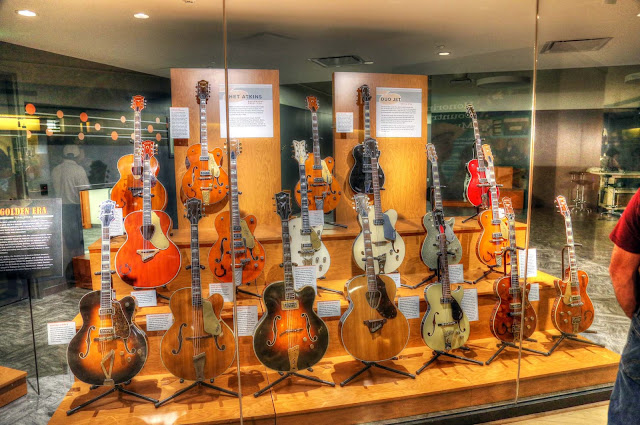We hopped off the GrayLine bus before we got back to the train station so we could visit the Country Music Hall of Fame and the Ryman Theater. Photos of the Ryman will be in another post.
Here is a little Wikipedia information on the Hall of Fame:
The Country Music Hall of Fame and Museum is one of the world’s
largest and most active popular music research centers and the world’s
largest repository of country music artifacts. Early in the 1960s, as the Country Music Association’s
campaign to publicize country music was shifting into high gear, CMA
leaders determined that a new organization was needed to operate a
country music museum and to carry out research and education activities
beyond CMA’s scope as a trade organization. Toward this end, the
nonprofit Country Music Foundation (CMF) was chartered by the state of Tennessee
in 1964 to collect, preserve, and publicize information and artifacts
relating to the history of country music. Through CMF, industry leaders
raised money to build the Country Music Hall of Fame and Museum, which
opened on April 1, 1967. Located at the head of Music Row, the museum
was erected on the site of a small Nashville city park. At this point,
artifacts began to be displayed and a small library was begun in a loft
above one of the museum’s galleries.[1]
Early in the 1970s the basement of the museum building was partially
complete, and library expansion began, embracing not only recordings but
also books and periodicals, sheet music and songbooks, photographs,
business documents, and other materials. At the outset, CMA staff had
run the museum, but by 1972 the museum (already governed by its own
independent board of directors) acquired its own small staff, which has
steadily increased to over 150 full-time professionals.
Building expansion took place in 1974, 1977, and 1984 to store and
display the museum’s growing collection of costumes, films, historic
cars, musical instruments,
and other artifacts. An education department was created to conduct
ongoing programs with Middle Tennessee schools, an oral history program
was begun, and a publications department was launched to handle books,
as well as the Journal of Country Music.
There are several video stations that loop historic country music groups and individuals performing. It is fascinating to watch these pioneers of country music and realize how it has changed over the years.
If you like looking at vintage and historic guitars, this is the place to be. I was never a great country music fan but I recognized so many of the performers who had their clothing and guitars memorialized in the Hall of Fame.
Ricky Puckett owned this nickel-plated guitar in the 1930's.
Webb Pierce had highly customized Pontiac....way over the top.
One of my all time favorite groups, The Lovin' Spoonful, added to Nashville's vocabulary with one of their songs...Nashville Cats.
The entry hall and food court at the Country Music Hall of Fame.
An inverted radio tower decorated the room where all the plaques of the members of the Hall of Fame hange on the walls.
The next post will be for our tour of the Ryman Theater in Nashville.



























No comments:
Post a Comment